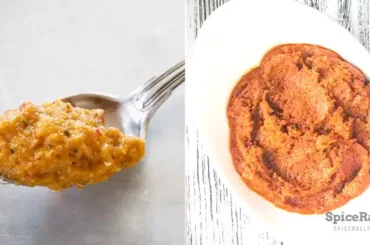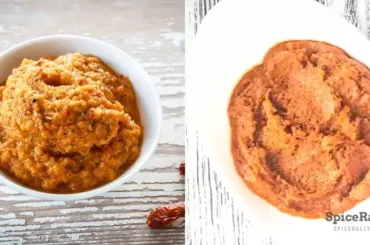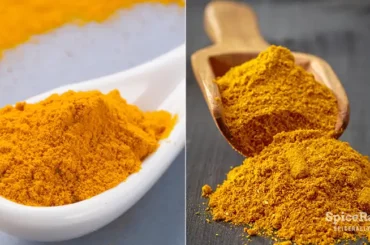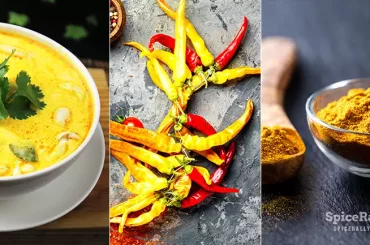Thai cuisine is globally renowned for using curry pastes to create lovely combinations of flavors. So, in this SpiceRally episode, we wish to bring facts about Thai Panang curry paste vs Thai red curry paste.
The primary difference between Thai panang curry paste and Thai red curry paste comes down to the contrasting ingredients used in each curry paste. In addition, Thai red curry paste is considered more powerful in terms of heat. In contrast, the panang curry paste tends to be bolder in spiciness with a richer and creamier flavor profile. Their usage in traditional Thai dishes also differs accordingly.

If these two curry paste ever confused you, and if you have doubts about what you must choose in your cooking, we are ready to clear your confusion from the rest of our article.
Thai Panang Curry Paste vs Thai Red Curry Paste- SpiceRally Drill Down
| Thai Panang Curry Paste | Thai Red Curry Paste | |
|---|---|---|
| Base ingredients | Dried and fresh herbs and spices | Thai red chiles in combination with other fresh spices and herbs |
| Ingredients used | Fresh and dried mild thai chiles Kaffir lime peel and leaves Galangal Garlic Lemongrass Cumin Nutmeg Shrimp paste Black/white peppercorns Peanuts Coriander seeds Shallots Green cardamom Coriander roots Salt Some variations might also include the following: Mung beans Maple syrup Peanut butter Avocado oil/soybean oil/ vegetable oil Star anise Cloves Chickpea paste or Miso paste Cinnamon Mace Store-bought products may have preservatives and additives | Thai red chilies White pepper Cumin seeds Kaffir lime peel Galangal Shallots Coriander root Coriander seeds Garlic Lemongrass Shrimp paste Salt Some variations might also include the following: Tomato paste Tomato ketchup Soy sauce Soybean oil Kaffir lime leaves Commercially made variations might consist of color additives, preservatives, and other flavorings |
| Flavor profile | Carries a punch of flavor with a more complex, vivid flavor profile than the red curry paste. Dried and fresh spices give a robust spiciness combined with a mild heat. Tangy, sweet, and umami undertones are more powerful than red curry paste. | The red curry paste has a depth of flavor with potent, bold, and rawly flavorful overtones than the panang curry paste. The depth of the red chiles is heightened while the overall flavor profile intensifies thanks to the fresh herbs and spices. |
| Color | Reddish-brown in color | Deep-reddish or dark reddish-brown. |
| Texture | Usually a coarse paste. But the texture can vary due to the depth of the grinding process. | Typically comes as a finely ground paste. |
| Heat Level | Less hot than the Thai red curry paste | Hotter than the Thai Panang curry paste |
| Level of spiciness | Spicier than the Thai red curry paste | Holds less spiciness than the Thai Panang curry paste |
| Main cooking application | Mainly used to make traditional Thai panang curries | Primarily used in making a variety of traditional Thai red curries |
| Other uses | -Can be used as a base for wet rubs and marinades. -Amps up savory noodles and rice dishes -Can be incorporated into sauces, dips, and salad dressings -Is an excellent addition to soups, stir-fries, and stews -Upgrades vegetable dishes, and can be mixed with roasted veggies | -Can be incorporated into ground meat mixtures to make meatballs, sausages, etc -Is a great addition to various egg recipes -Works as a flavor enhancer for marinades and wet rubs -Can be used to mix into pasta, spaghetti, and noodle dishes -Flavors up soups, stews, and stir-fries, working as a base for those dishes |
| Category of culinary ingredient | Cooking ingredient | Cooking ingredient |
| Availability | -Can be found anywhere across Thailand -You may have to check with certain online sellers, leading supermarkets, and Asian stores when it comes to purchasing Panang curry paste outside of Thailand | -Can be found anywhere across Thailand -Is readily available in leading supermarkets, online shopping sites, most grocery stores, and Asian stores even outside of Thailand |
| Storage | Unopened, shop-bought products can be kept outside at room temperature. Opened store-bought products and homemade ones should be refrigerated or frozen after every use to have a longer shelf life. | Unopened, shop-bought products can be kept outside at room temperature. Opened store-bought products and homemade ones should both be refrigerated or frozen after every use to have a longer shelf life. |
| Mode of Production | Homemade and commercially produced versions exist | Homemade and commercially produced versions exist |
| Variations | Specific variations do not exist but sometimes the recipe might have slight differences depending on the production or chef. | Specific variations do not exist but sometimes the recipe might have slight differences depending on the production or chef. |
| Origin | Central or Northern Thailand | Central Thailand |
Elaborating on The Difference Between Thai Panang Curry Paste and Thai Red Curry Paste
The usage of curry pastes is nothing new to Thai cuisine. They are connoisseurs in finding the perfect balance between the layers of flavors in their traditional dishes. Most authentic Thai dishes are defined by the taste of curry pastes. And, they put together so many exotic flavor elements in just one plate.
Each curry paste has its own characteristic flavor profile. Therefore, it is important to distinguish the similarities and dissimilarities between them. Likewise, Thai panang curry paste and Thai red curry paste are also two of the main Thai culinary ingredients used in many cooking applications.
Difference In The Content Of Each Curry Paste…
Regardless, both being curry pastes, they are different in terms of ingredients, flavor profile, aroma profile, texture, and color. As we have illustrated in the table above, Thai panang curry paste is a combination of both dried and fresh herbs and spices, making the foundation flavor of this curry paste.
It also incorporates peanuts giving a signature creaminess and a richer texture than any other basic curry pastes you find in Thai cuisine. On the contrary, Thai red curry paste is considered the most famous type of curry paste in Thai cooking.
It is accountable for its characteristic bold flavor, aromatic nature, and rich color. Thai red curry paste is more widely used in traditional Thai dishes than Thai panang curry paste is being used. But, it does not have the richness that the panang curry paste holds.
In addition, Thai red curry paste tends to be more robust in heat due to the inclusion of hot and mild Thai red chiles, But, the Panang curry paste often includes very mild Thai red chiles.
The Variations in Flavor Profiles
Thai red curry paste usually contains a straightforward, raw flavor profile. At the same time, panang curry paste carries many undertones which can be described as spicy, tangy, sweet, and umami. The red curry paste has cumin and coriander as the only dry spices most of the time.
But, panang curry paste contains a variety of dry spices that combine with fresh ingredients to create a complex taste profile. The inclusion of various spices (even the ones that are not familiar to Thai cuisine), makes us question if panang curry paste has origins in other neighboring cuisines as well.
The Differences and Similarities in Usage
Thai panang curry paste is specifically used to make traditional Thai panang pork curry (Panang Moo) and Thai panang chicken curry. On the other hand, the usage of red curry paste is extensive and is used in a variety of red curries.
Both of these curry pastes are applicable to many other cooking methods. But, the red curry paste holds the most versatility in terms of usage. However, both curry pastes pair best with coconut milk-based dishes. But, the panang curry paste has a special ability to team up well with other cream-based recipes.
Therefore, we cannot prioritize one out of these two and mark only one as the best curry paste. Both of them are flavorful, and unique in their own character, defining traditional Thai dishes in the best way they can.
Can Thai Red Curry Paste And Thai Panang Curry Paste Be Used In Place Of Each Other?
Well, this is a tricky situation as it can be Yes and No depending on the dish you wish to substitute. Using the red curry paste to make traditional panang curries and panang curry paste to make traditional red curries be a straight No as they can ruin the identities of each dish.
Yet, you can still use them in place of each other when it comes to other dishes where the curry pastes are called a secondary ingredient. Since both of them have many similar ingredients and the iconic “curry” touch, you could be using the panang curry paste instead of the red curry paste and vice versa.
However, you should be mindful of the flavor difference they make. Both will be accountable for giving you a red curry but the flavors can be very different.




